Jamaica’s net international reserves (NIR) are at US$3.3 billion in March this year is now at the highest level since hitting a brief high of $3.67 billion in August 2017 has grown 50 percent since the start of January 2016 and 35 percent since the end of 2015.
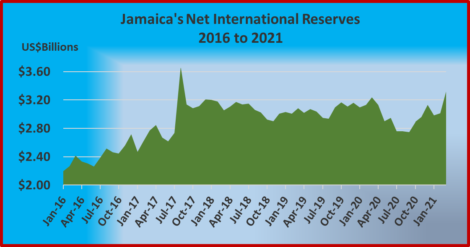 During 2016, the NIR remained under US$2.6 billion up to November before reaching a high for the year of just over $2.7 billion and ended the year with an average of US$2.4 billion. The average for 2017 up to August was US$2.68 billion, with April with the highest of US$2.85 billion.
During 2016, the NIR remained under US$2.6 billion up to November before reaching a high for the year of just over $2.7 billion and ended the year with an average of US$2.4 billion. The average for 2017 up to August was US$2.68 billion, with April with the highest of US$2.85 billion.
After peaking in August, the NIR fell back to US$3.1 in September and remained above the US$3 billion levels until October 2018, when it dipped briefly below and moved back above it in December of that year. It remained above $3 billion levels until June 2019 and dipped briefly below in July and August. In September, it moved back above it until April 2020. By September last year, the NIR slipped to US$2.75 billion and started to rebuilds reaching over US$3.1 billion in December, a month for healthy inflows and reduced demands. There was a slight slip below US$3 billion in January to US$2.98 billion, but by the end of February, it moved back above the US$3 billion levels before hitting a recent high of US$3.3 billion at the end of March.
The increased NIR comes against a dramatic fall in local interest rates, with the Treasury bill rates falling for 6 percent for 91 days instrument at the start of 2016, to just 1.94 percent in April this year. The latest increase in the NIR took place when tourism, one of the country’s major foreign exchange earners, was operating around a third of its capacity since the second half of 2020.
World Bank and CDB funds swell NIR
Net International Reserves surged 10 percent in March with a rise of US$303 to US$3.32 billion from US$3.016 billion at the end of February this year.
 The buildup comes against a huge selloff of US dollars by dealers in the market between January and March, but the bulk of the increase did not come from normal inflows, information provided to this publication by Bank of Jamaica (BOJ) indicates. BOJ, in response to ICInsider.com enquiry as to the source for the increase, states “the growth of approximately US$303 million in the NIR for the month of March 2021 was mainly influenced by government-related receipts of approximately US$217 million; of which, US$175 million represented multilateral loan inflows from the World Bank and the CDB. The remainder of the inflows were received from authorised dealers and Cambios, under the Bank’s Surrender Arrangement.”
The buildup comes against a huge selloff of US dollars by dealers in the market between January and March, but the bulk of the increase did not come from normal inflows, information provided to this publication by Bank of Jamaica (BOJ) indicates. BOJ, in response to ICInsider.com enquiry as to the source for the increase, states “the growth of approximately US$303 million in the NIR for the month of March 2021 was mainly influenced by government-related receipts of approximately US$217 million; of which, US$175 million represented multilateral loan inflows from the World Bank and the CDB. The remainder of the inflows were received from authorised dealers and Cambios, under the Bank’s Surrender Arrangement.”
Estimated Reserves represents 53.65 weeks of Goods Imports and 38.71 weeks of Goods & Services Imports. At the end of December, the reserves were $3.13 billion but fell by $148 million in January to $2.98 billion and then increased by marginally to the close of February.
The boom continues
Net remittance inflows for January this year jumped a massive 39 percent or US$63 million above the January 2020 inflows to US$224.4 million, data from Bank of Jamaica shows.
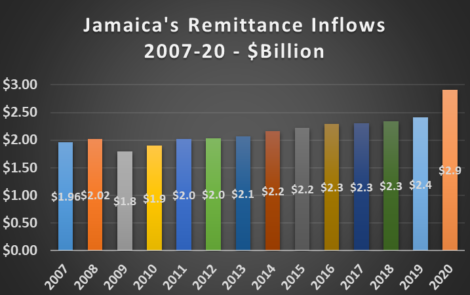 The sharp increase follows from the strong rise seen since May last year when inflows grew 41.6 percent, with the remaining months of the year increasing over thirty percent, except November that grew by 19 percent. For January this year, gross remittance inflows grew 32.7 percent or US$59.4 million to US$241 million. The trends suggest that the country could see earnings from this are exceeding US$3 billion for the first time, having grossed US$2.9 billion in 2020 and increased by US$500 million or 21 percent. According to data out of Jamaica’s central bank from 2013 up to 2019, remittance inflows have grown by an average of US$57 million per annum or 3%. The year with the highest increase was 2014 when a four percent rise delivered provided the country with a $92 million increased inflows and the year with the lowest increase was 2017 with an increase of just $14 million for a one percent rise.
The sharp increase follows from the strong rise seen since May last year when inflows grew 41.6 percent, with the remaining months of the year increasing over thirty percent, except November that grew by 19 percent. For January this year, gross remittance inflows grew 32.7 percent or US$59.4 million to US$241 million. The trends suggest that the country could see earnings from this are exceeding US$3 billion for the first time, having grossed US$2.9 billion in 2020 and increased by US$500 million or 21 percent. According to data out of Jamaica’s central bank from 2013 up to 2019, remittance inflows have grown by an average of US$57 million per annum or 3%. The year with the highest increase was 2014 when a four percent rise delivered provided the country with a $92 million increased inflows and the year with the lowest increase was 2017 with an increase of just $14 million for a one percent rise.
Remittances jump 21% or US$500m in 2020
Remittance inflows to Jamaica is up a strong 21 percent for 2020, with inflows jumping US$499.4 million to a record US$2.905 billion for January to December 2020 period, with the United States contributing US$386 million of the increase, data out of Bank of Jamaica shows.
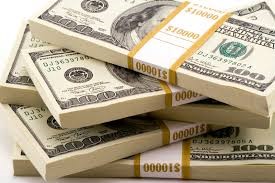 The USA accounted for $1.69 billion of total inflows while the United Kingdom provided US$271 million. up by $34 million, Canada delivered US$52 million more than in 2019 after landing US$257 million in 2020. Contributions from the Cayman Islands, Jamaica’s fourth largest contributor to the country’s remittances, were virtually flat year over year, with US$145 million of inflows in 2020 versus US$142 million in 2019.
The USA accounted for $1.69 billion of total inflows while the United Kingdom provided US$271 million. up by $34 million, Canada delivered US$52 million more than in 2019 after landing US$257 million in 2020. Contributions from the Cayman Islands, Jamaica’s fourth largest contributor to the country’s remittances, were virtually flat year over year, with US$145 million of inflows in 2020 versus US$142 million in 2019.
In the first two months of the year, gross inflows rose 9 percent and 8 percent, respectively, but fell 9 percent in March and 10 percent in April, compared with the same periods in 2019. In May, inflows rose 16 percent but jumped sharply by 42 percent in June, to record the highest growth for the year with inflows of $275 million. The other months of the year grew in the 30 percent range, except for November that increased by 19 percent.
Inflows for December grew 35 percent to record the highest monthly inflow for the year at US$301 million. July followed with US$293 million, increasing 37 percent over the 2019 period and August was next with US$280 million with an increase of 31 percent over 2019.
Jamaica’s NIR jumps US$146m
Jamaica’s Net International Reserves jumped US$146 million in October to reach US$2.89 billion. The net reserves balance is coming from US$2.75 billion at the end of September.
 Gross reserves rose by $146 million to $3.86 billion, including US$966 million due to the International Monetary Fund. The October increase is the first major rise in net reserves for 2020. In March, the NIR rose to US$3.24 billion from US$3.13 billion. By May, it slipped to US$2.9 billion and ended July at US$2.76 billion.
Gross reserves rose by $146 million to $3.86 billion, including US$966 million due to the International Monetary Fund. The October increase is the first major rise in net reserves for 2020. In March, the NIR rose to US$3.24 billion from US$3.13 billion. By May, it slipped to US$2.9 billion and ended July at US$2.76 billion.
The improvement in the NIR comes against the background of foreign exchange Canbio dealers buying US$424 million from the public and selling $373 million in October as Authorized Dealers bought US$628 million and sold $668 million. Cambios and Authorized Dealers must surrender around 10 percent of all foreign exchange funds purchased to the central bank.
More gains for Jamaican Dollar
The Jamaican dollar closed trading on Thursday at $144.48, an improvement over Wednesday’s closing selling rate of $145.30 to one US dollar.
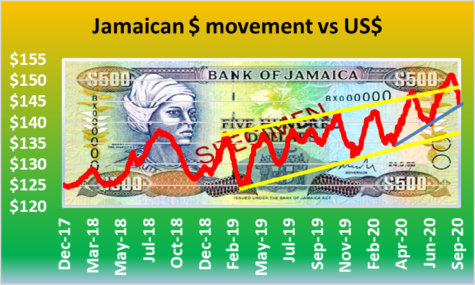 Since August when the rate hit a low of $151.27 against the US dollar, the local dollar has rebounded 4.5 percent. A number of developments have occurred to help the local currency. Unbeknown to many is an issue of $5 billion government bond with a duration of more than 30 years that pulled liquidity out of the market to purchase them at an average rate of just over 7 percent, there was also another issue at the beginning of September for J$3 billion bonds resulting in an average rate of 2.91 percent for the instrument that has a two and a half years life. In addition, the reopening of the tourism sector would be adding some badly needed US dollars to the system.
Since August when the rate hit a low of $151.27 against the US dollar, the local dollar has rebounded 4.5 percent. A number of developments have occurred to help the local currency. Unbeknown to many is an issue of $5 billion government bond with a duration of more than 30 years that pulled liquidity out of the market to purchase them at an average rate of just over 7 percent, there was also another issue at the beginning of September for J$3 billion bonds resulting in an average rate of 2.91 percent for the instrument that has a two and a half years life. In addition, the reopening of the tourism sector would be adding some badly needed US dollars to the system.
The trendlines shown in yellow, on the chart suggest further appreciation that could take it below $140 to one US dollar. The chart shows the local currency on an upward rise since December 2018 as it meanders upwards to hit the low point in August and has since been correcting. It could return to the support line at around $138 later in the year but it could face resistance at the $144 region.
In Thursday’s trading, dealers sold $58 million at $144.48 and bought US$42 million at an average rate of $143.36. National Commercial Bank was the biggest seller on Thursday with US$18.3 million at a rate of $144.20, up from $7.7 million sold on Wednesday, while they bought just US$3.5 million on Thursday at $141.10. JN Bank bought just US$315, 000 at an average of $141.10 and sold US$8.8 million at $143.75. Mayberry Investments bought US$4.6 million at an average of $144.21 and sold only $873,000 at $144.59.
Jamaican$ improved value
The Jamaican dollar closed trading on Tuesday at $145.91 to one US dollar, with dealers selling US$60 million after buying US$51.4 million at an average rate of $144.81. The improved value for the local currency compares with the August 19 low of $151.27 for each US dollar.
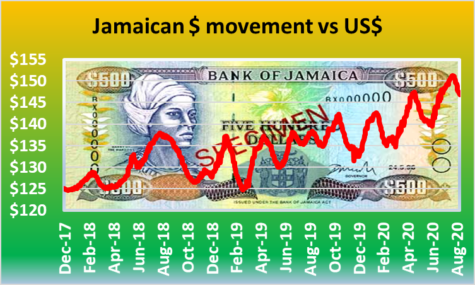 On Monday, dealers sold US$36.5 million at an average of $146.89, while dealers bought just US$23.2 million, at an average rate of $144.02.
On Monday, dealers sold US$36.5 million at an average of $146.89, while dealers bought just US$23.2 million, at an average rate of $144.02.
The big sellers on Tuesday were Bank of Nova Scotia, US$9.6 million at an average of $147.23 after buying a mere US$2.3 million at $142.04. JN Bank bought just $336,000 at $138.16 each and sold US$4.4 million at $142.14 each and National Commercial Bank bought US$6.5 million at an average of $144.79 and sold US$14.4 million at $145.42. JMMB Bank bought US$8.7 million at $143.34 and sold only US$688,334 at $146.19 while JMMB Securities bought US$6.4 million at $146.72 each and sold US$7 million at $146.99. Чтобы играть в онлайн казино России безопасно и без ограничений, пользователям нужно пройти специальную идентификацию. В процессе проверки, казино онлайн России может убедиться, что игрок настоящий и ему можно доверять. Стоит отметить, что в рейтинге по отзывам мобильное казино на реальные деньги используют современные технологии шифрования, а также ответственно относятся к конфиденциальности данных игроков. Это позволяет игрокам быть уверенными, что они могут играть анонимно, а их паспортные данные не будут переданы третьим лицам.
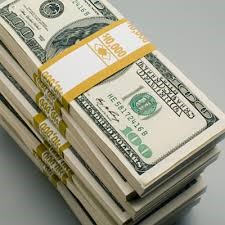 Data out of Bank of Jamaica shows purchasing by Authorized dealers and Cambios for the year to March 4 amounts to $777 million US$103 million more than in 2020, while selling was just $33 million more in 2021 than in 2020. This development is a huge revelation with the tourism sector, a large foreign exchange sector operating around a third of capacity compared to a full capacity for the similar period last year.
Data out of Bank of Jamaica shows purchasing by Authorized dealers and Cambios for the year to March 4 amounts to $777 million US$103 million more than in 2020, while selling was just $33 million more in 2021 than in 2020. This development is a huge revelation with the tourism sector, a large foreign exchange sector operating around a third of capacity compared to a full capacity for the similar period last year. Last year, trading on the first Monday in March brought in US$73,900,712 while selling amounted to US$73,904,949. Tuesday’s purchases amounted to US$44,971,292 and selling US$65,382,991, while on Wednesday purchases were US$55,679,393 and sales US$79,738,789 and on Thursday, March 5 last year, dealers purchased US$53,369,689 from the system and sold US$47,373,166.
Last year, trading on the first Monday in March brought in US$73,900,712 while selling amounted to US$73,904,949. Tuesday’s purchases amounted to US$44,971,292 and selling US$65,382,991, while on Wednesday purchases were US$55,679,393 and sales US$79,738,789 and on Thursday, March 5 last year, dealers purchased US$53,369,689 from the system and sold US$47,373,166.
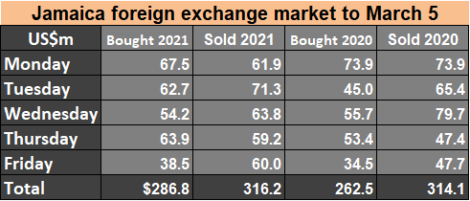 Others are confirming increased flows from the BPO sector that has grown over 2020, increased remittances and exports. Additional flows may be coming from entities or individuals who bought last year in anticipation of the local dollar running away but may have decided to cash in with the price peaking around the $150 million mark.
Others are confirming increased flows from the BPO sector that has grown over 2020, increased remittances and exports. Additional flows may be coming from entities or individuals who bought last year in anticipation of the local dollar running away but may have decided to cash in with the price peaking around the $150 million mark. For the week to Thursday, NCB sold off a net of US$24 million. Dealers bought US$32 million on Thursday and sold US$56.6 million compared to buying US$46.8 million and selling US$51.4 million on Wednesday at an average rate of $142.6258. On Thursday, NCB sold a net of nearly US$20 million.
For the week to Thursday, NCB sold off a net of US$24 million. Dealers bought US$32 million on Thursday and sold US$56.6 million compared to buying US$46.8 million and selling US$51.4 million on Wednesday at an average rate of $142.6258. On Thursday, NCB sold a net of nearly US$20 million.
 The Jamaican dollar hit a low of $151.27 against the US dollar in August and has rebounded since to trade at $145.3 on Wednesday with one technical indicator showing that it could appreciate further.
The Jamaican dollar hit a low of $151.27 against the US dollar in August and has rebounded since to trade at $145.3 on Wednesday with one technical indicator showing that it could appreciate further. In Wednesday’s trading, dealers sold $64.8 million at $145.306 having bought US$55.8 million at an average rate of $144.43. In trading, Scotia Bank bought US$8.5 million more than they sold. First Global, JMMB Bank, National Commercial Bank and Victoria Mutual Building Society sold far more US dollars than the bought.
In Wednesday’s trading, dealers sold $64.8 million at $145.306 having bought US$55.8 million at an average rate of $144.43. In trading, Scotia Bank bought US$8.5 million more than they sold. First Global, JMMB Bank, National Commercial Bank and Victoria Mutual Building Society sold far more US dollars than the bought.




